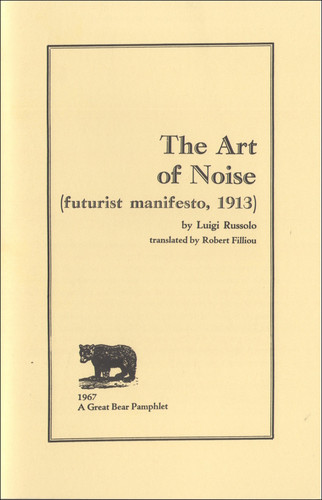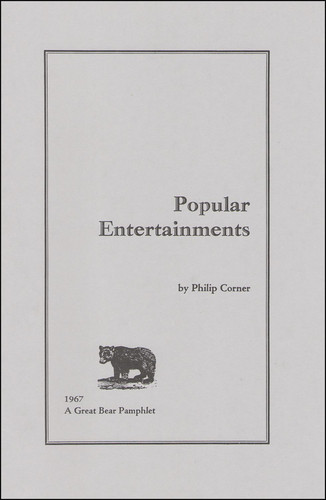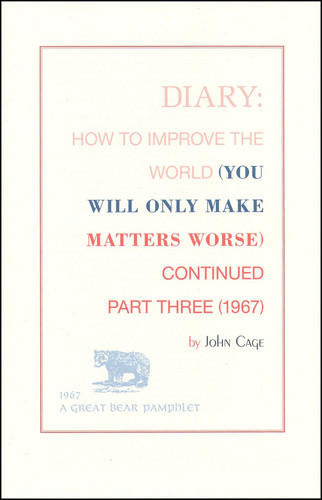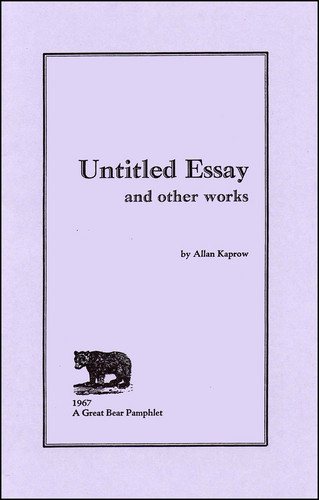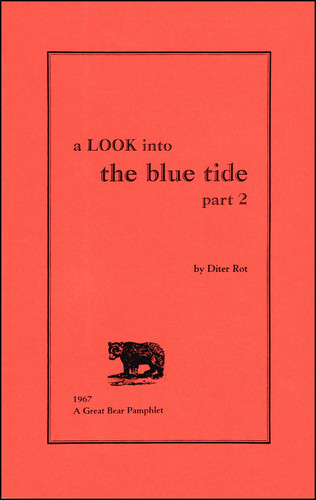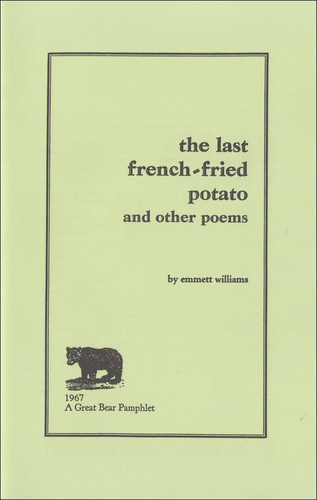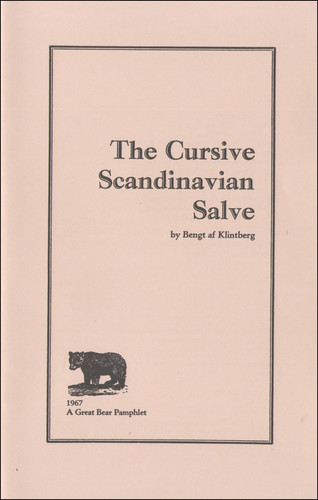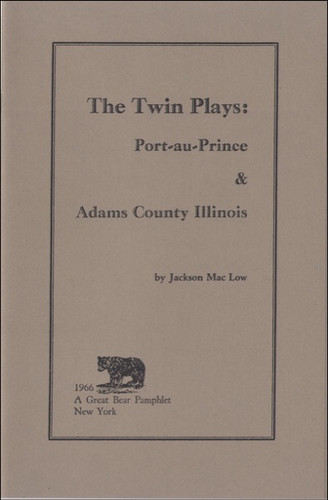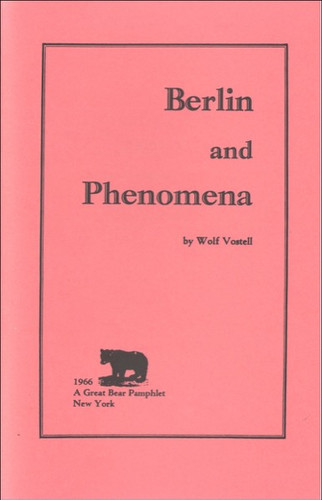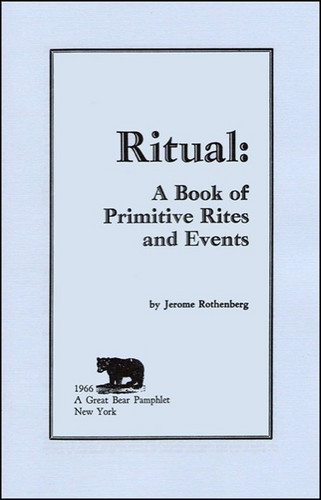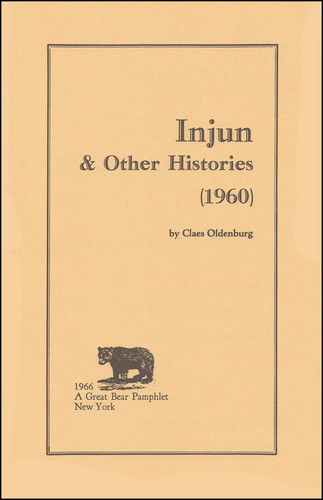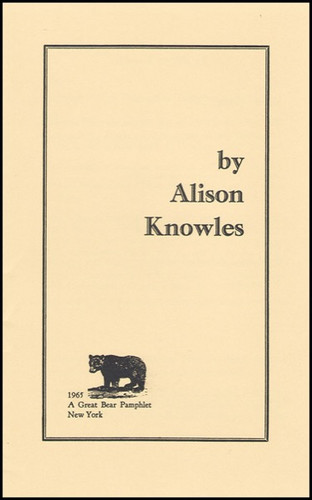A Great Bear Pamphlet Series
The Art Of Noise (Book)
** 2024 Stock ** The Art of Noise presents the 1913 Futurist manifesto “L’arte dei Rumori” as translated by Robert Filliou. Luigi Russolo calls for an infinite expansion of musical vocabulary and sensibility in coordination with that of industrial machinery—“We must enlarge and enrich more and more the domain of musical sounds”—envisioning a machine-based music that would dispense entirely with inherited forms. This publciation made the text widely available in English for the first time. Also i…
Popular Entertainments (Book)
** 2024 Stock ** This collection of musical works is as visually and poetically striking as any of the Great Bears, with the individual pieces flowing together in a sprawling collage. Philip Corner’s Popular Entertainments incorporate pop music as a raw material and a motor, an ever- changing sound source with an aura of heightened energy: pulsating rhythms, dancing, and the frenzy of teenage fans. The spectacular, molten immediacy of the work—which prioritizes intense experiences of listening v…
Diary: How to Improve the World (You Will Only Make Matters Worse) Continued Part Three (Book)
** 2024 Stock ** The third in John Cage’s series of “Diary” essays (the other parts were published in different contexts), defined broadly as “collections of thoughts that develop out of working and being alive.” The text is formally and discursively roving: its margins, typeface, and color undergo continuous alteration by chance methods as Cage contemplates computers, Erik Satie; life on the road with Merce Cunningham; death; encounters with Mies van der Rohe, Duchamp, and Marshall McLuhan; boo…
Untitled Essay and Other Works (Book)
** 2024 Stock ** This pamphlet presents scenarios for three narratively elaborate Happenings—“Mushroom” (1962), “Paper” (1964), and “Interruption” (1967)—and a key early statement, which originally accompanied the first published Happening in 1958. The essay forcefully propounds Allan Kaprow’s ideas on the practice of art as a radical form of life that perpetually reinvents itself.
Originally published by Something Else Press between 1965 and 1967, the Great Bear Pamphlet series was envisioned b…
A Filliou Sampler (Book)
** 2024 Stock ** The centerpiece of this collection of short works by Robert Filliou is “Yes (An Action Poem),” a performance work involving an extended anatomical analysis of the “adult male poet” (originally performed in collaboration with Alison Knowles and Philip Corner). Also included are several short “plays,” a poem for Emmett Williams and Daniel Spoerri, and a performance work entitled “Five Ways to Prepare for a Space Trip,” all dated 1958-1964.
Originally published by Something Else Pr…
A Look Into The Blue Tide: Part 2 (Book)
** 2024 Stock ** The Blue Tide is a vast, multi-part work that developed out of a diary Diter Roth kept while teaching in the United States between 1964 and 1966 (which Edition Hansjörg Mayer had published in a full-color edition earlier in 1967). This publication consists of excerpts from the continuation of that work—all translated by Roth himself “from color + german into blackandwhite + english”—as well as sketches, diagrams, poetry, and assorted writing.
Originally published by Something El…
The Last French-Fried Potato and Other Poems (Book)
A short but potent collection of poems by Emmett Williams, a central player in Fluxus and the Concrete poetry movement and one of the editors of the Great Bear series. The titular work—subtitled “the ultimate poem”and improvised around the eating of french fries—was originally performed with Robert Filliou in 1964. The six poems herein are characterized on the whole by compulsive flows of language, with short, piston-like lines carrying out obsessive serial modulations to create a perpetually un…
The Cursive Scandinavian Salve (Book)
Poet and anthropologist Klintberg was one of the earliest Scandinavian participants in Happenings and Fluxus. The Cursive Scandinavian Salve collects a number of event scores and scenarios that maintain a lyrical dialogue with Sweden’s oral traditions and picturesque landscape’s subtle evocations are counterbalanced by a continual, prankish flirtation with danger and volatility. This book includes several collaborations with and dedications to Åke Hodell, Sten Hanson, and Henning Christiansen, a…
The Twin Plays: Port-au-Prince & Adams County Illinois (Book)
** 2021 Stock ** This pamphlet is comprised of a pair of structurally identical plays, each composed by means of chance operations around the time of the editing and publication of An Anthology of Chance Operations by Mac Low with La Monte Young. Each play is made up of five partially improvised conversations in which the dialogue is derived from a highly restricted lexicon: the first uses words made from the letters that spell out the word “Port-au-Prince” to construct nonsensical “pseudo-sente…
Berlin and Phenomena (Book)
** 2021 Stock ** This pamphlet records Vostell’s two titular large-scale performance pieces “Berlin” and “Phenomena,” both carried out in mid-60s Berlin alongside a host of accomplices. “Berlin” consisted of 100 timed events—performed in both public and private—over a seven hour period, with equal weight given to utterly mundane actions like “looking for a parking place,” and more spectacular actions like “following the second hand of a watch with a welding torch.” “Phenomena” was a Happening se…
Ritual: A Book of Primitive Rites and Events (Book)
** 2021 Stock ** This collection of event scores and descriptions adapted from a range of ethnographic sources also implicitly functions as an examination of the Happenings movement in an expanded historical and anthropological context. Rothenberg’s translations, along with the restriction of information on his sources in the table of contents, leave ample room for cultural and historical ambiguity, giving each event a strong foothold in the here and now. Ritual stands as a direct predecessor to…
Incomplete Requiem for W. C. Fields (Book)
** 2021 Stock ** Though the title indicates an “incomplete” piece, this pamphlet presents the complete poem originally performed by Al Hansen in New York in 1958, at the intersection of the “backwash from the San Francisco Poetry Revolution” and the dawn of Happenings. Hansen read the poem aloud while a hand-spliced assemblage of W.C. Fields’ films was projected onto his chest. The pamphlet’s introduction, written by Hansen in 1966, consists of recollections of the New York art and poetry scenes…
Injun & Other Histories -1960 (Book)
** 2021 Stock ** This breezy and acerbic collection of early writings and illustrations by Oldenburg presents gnomic visions of an earlier America. Claes Oldenburg’s hand shines through in the loose, vivid prose and in the overall presentation. The pamphlet includes “Two Scenarios from an Incomplete Pageant of America,” a pair of excerpts from the longer, unfinished narrative “Faustina,” and a postscript.
Originally published by Something Else Press between 1965 and 1967, the Great Bear Pamphlet…
A Book About Love & War & Death: Canto One (Book)
** 2021 Stock ** This first section of Higgins’ major work, A Book About Love & War & Death, a sprawling prose poem meant to be read aloud. The text evolves modally, cycling through language games and experiments, oblique autobiography, and vocabulary drawn from an Indonesian dictionary, with a use of a chance method that is both elaborate and informal. The guiding principle of the work is, above all, what Higgins saw as a density of conceptual imagery—a density to be unraveled somewhat in what …
By Alison Knowles
** 2021 Stock ** This collection of scores presents a comprehensive overview of Knowles’ seminal early performance/event pieces from 1961 to 1965. These scores range from well-known directives (“Make a salad” and “Tie up the audience”) to more elaborate orchestrations, including pieces conceived for Nam June Paik and George Brecht and several relating to Knowles’ work as a printer.
Originally published by Something Else Press between 1965 and 1967, the Great Bear Pamphlet series was envisioned b…
